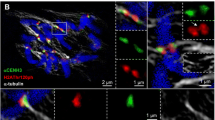Abstract.
Immunofluorescence staining with an antiserum raised against a presumptive meiotic histone, which has been shown to appear prior to male meiosis in liliaceous plants, preferentially stained the centromere (kinetochore) region of meiotic chromosomes in microsporocytes and megasporocytes. Using this antiserum, we were able clearly to visualize the centromeres at all important meiotic stages in microsporocytes, namely, the association and fusion of centromeres of homologous chromosomes at zygotene-pachytene in prophase I, the disjunction of the homologous centromeres at diplotene, the doubling of each centromere at metaphase I and nonseparation of the sister centromeres at anaphase I, by confocal laser scanning microscopy. Thus, this report provides a complete picture of the behavior of centromeres during meiosis in a eukaryote for the first time. This antiserum also decorated centromeres during female meiosis in cryo-sectioned megasporocytes, but did not stain the centromeres of mitotic chromosomes in root-tip meristem. From these observations, it is suggested that a meiosis-specific centromere protein is required for the meiosis-specific behavior of the centromere.
Similar content being viewed by others
Author information
Authors and Affiliations
Additional information
Received: 12 May 1997; in revised form: 20 August 1997 / Accepted: 25 August 1997
Rights and permissions
About this article
Cite this article
Suzuki, T., Ide, N. & Tanaka, I. Immunocytochemical visualization of the centromeres during male and female meiosis in Lilium longiflorum . Chromosoma 106, 435–445 (1997). https://doi.org/10.1007/s004120050265
Issue Date:
DOI: https://doi.org/10.1007/s004120050265




